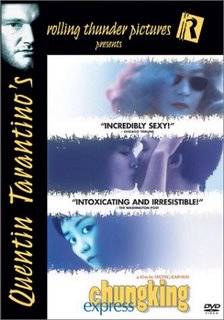
Black Rebel Motorcycle Club - Howl (5/5)
“It’s time for a howdown ma’! Invite the cousins over and put the new ‘Black Rebel’ in dat ‘dem der new fangled disc playin’ merchine. Heeeeeehaw!”
No, no, no! Despite what everyone’s claiming, B.R.M.C. have not gone country—they’ve gone retro!
I’ve always wondered why a band who took their cue from the 80’s rock group The Jesus and Mary Chain would name the band after Marlon Brando’s gang in the 1953 film The Wild One. I don’t recommend judging a book by its cover but judging by B.R.M.C.’s name I would have expected something along the lines of The Raveonettes. If they’re going to name their group after a fictitious gang I would suggest The Lords of Hell (on a side note, you have to give props to a family film that keeps the line, “Don’t fuck with the Lords of Hell). On B.R.M.C.’s latest they take their sound back to the roots of rock and up the folk and country influences, but at its heart it sounds like 1950’s rock ‘n roll—well, with 50 years of musical evolution having more than a little influence.
B.R.M.C. came out of the gates with a ridiculous amount of hype (it was probably New Music Express). They were just asking for a smack down. When their solid debut album came out plenty of critics dismissed them as Jesus and Mary Chain rip-offs (fair enough) and then declared B.R.M.C. were juvenile delinquents who would amount to nothing (a little harsh I thought). When B.R.M.C.’s follow up, Take Them On, On Your Own, was a little sophomore slumpish you could hear bones splintering around the world as critics collectively broke their arms while patting themselves on the back. Things only got worse when B.R.M.C. were dropped from their label. To top it all off an ex-girlfriend stole their dog and showed up at a show only to make out with every guy there.
Down but not out, the B.R.M.C. have return with a triumphant left hook. Howl isn’t a return to form, it’s a complete reinvention. The Jesus and Mary Chain posturing is downplayed while folk, country, and gospel are embraced. The sounds conjure up the dustbowl west complete with lone churches set against a flat landscape. It’s hard to tell whether the incantations of religion are sincere or merely dressing for the new sound, but in the end I don’t think it matters much. Even if the album is style over substance, they have enough style so that it doesn’t matter. For a band to do a complete overhaul like this is impressive to say the least. I hope the attention Howl is getting will force those critics who dismissed B.R.M.C. to take another look.
I read that the title of the album, Howl, is a reference to the Allen Ginsburg poem of the same name. I don’t really see much of a connection. “Howl” the poem is loaded with urban imagery that Ginsburg seems so intent on railing against. At one point he intones “Moloch whose skyscrapers stand in the long streets,” likening the urban landscape to the Old Testament idol the unfaithful worshiped. Despite Ginsburg’s distaste for concrete surroundings, his poem has its feet firmly planted in a city if only to condemn it. Ginsburg’s “Howl” strikes me as a Jeremiad pointing to a new way of life in an increasingly conservative America. B.R.M.C. are much closer to On the Road, the novel that follows Kerouac’s persona as he crisscrosses the country as if he was running from his Bible-black Catholic roots. It has the same grand sense of movement and a tortured sense of religion that would ultimately consume Kerouac just like his alcoholism.
My three favorite tracks: “Howl,” “Ain’t No Easy Way,” and “Sympathetic Noose.” Despite the organ, the title track sounds as if it has one foot dipped in B.M.R.C.’s last two albums (come to think of it, “Salvation” could probably have gone on this album with no problems). “Ain’t No Easy Way”—the obvious single—is a taunt song that ruminates on how it’s much easier to fall into love than to completely escape it. “Sympathetic Noose” makes great use of studio trickery. The song starts with the strumming of a raw sounding acoustic guitar only to have it backed by a percussion section that can only be produced by modern day electronics. It’s a great dichotomy, and in my opinion the best moment on the CD.
The B.M.R.C. have tossed off their leather jackets, gave their old label the finger, and completely revamped their sound. After listening to this album you might be asking yourself, “What are they rebelling against?” B.R.M.C. would pointedly shoot back, “Whaddya got?”



